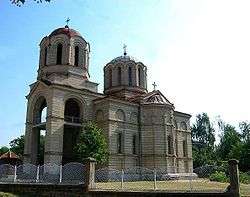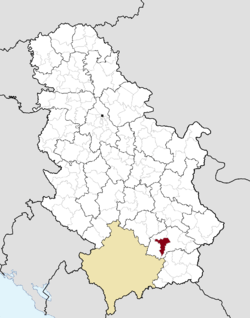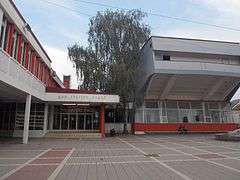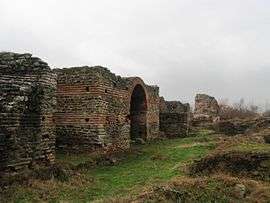Lebane
Lebane (Serbian Cyrillic: Лебане) is a town and municipality located in Jablanica District of southern Serbia. According to the 2011 census, the town has a population of 10,062 inhabitants, while the municipality has 20,000 inhabitants.
Lebane Лебане | |
|---|---|
Town and municipality | |
 Serbian Orthodox church | |
 Coat of arms | |
 Location of the municipality of Lebane within Serbia | |
| Coordinates: 42°55′N 21°44′E | |
| Country | |
| Region | Southern and Eastern Serbia |
| District | Jablanica |
| Settlements | 39 |
| Government | |
| • President | Ivan Bogdanović (SNS) |
| Area | |
| • Town | 9.40 km2 (3.63 sq mi) |
| • Municipality | 337 km2 (130 sq mi) |
| Elevation | 275 m (902 ft) |
| Population (2011 census)[3] | |
| • Town | 10,062 |
| • Town density | 1,100/km2 (2,800/sq mi) |
| • Municipality | 22,000 |
| • Municipality density | 65/km2 (170/sq mi) |
| Time zone | UTC+1 (CET) |
| • Summer (DST) | UTC+2 (CEST) |
| Postal code | 16230 |
| Area code | +381(0)16 |
| Car plates | LB |
| Website | www |
Geography
The town is located at the confluence of the rivers Jablanica and Šumanska Reka, in the alluvial plain created by the former. Just northeast of the town a larger plain called Leskovačko polje extends toward the town of Leskovac, which is the district seat. The elevation of the town of Lebane is between 275.2 and 420 MASL.
History
- Prehistory and Medieval times
The favorable location and the richness of nature made Jablanica valley important place since the earliest times. Traffic affordable and fertile, Leskovac valley has provided favorable conditions for the settlement of population. Archaeological findings, of which the most important are Hissar and Caričin grad (Iustiniana Prima) show that life in this area, continuously evolved from prehistoric man to date.
First mention of Lebane as Hlebane dates back to 1512.
- After the liberation from the Ottomans
Lebane is formed as a village of the same name after the liberation in 1878. Visiting Serbia in 1880s, M. Rakic writes about it as a "big village populated by Serbs, in a valley, on the river Jablanica, on its left bank." Only when Lebane got the role of Jablanica district headquarters, it began to gradually develop in a direction of a small town.
The core of this small town was a series of houses along the Jablanica which is 45m wide here (as is even now); at the end of this series are the buildings of the Court and Municipality. The main feature of this town were two huge cottonwood trees with a volume of not less than 10 m and three huge walnut tree on the right bank of the river, near the pedestrian bridge. One of these cottonwoods survived as one of the most recognizable Lebane's landmarks, in front of the Justiniana - Caričin Grad hotel, until 2008, when it was hit by a lightning and had to be removed.
Lebane has always been a Christian village with about forty houses scattered on the hill near the river. In 1900 it had 67 houses with 460 inhabitants.
- World War 1 and interwar period
During WWI Lebane population suffered greatly from Bulgarian occupiers. Because of forcible mobilization of youth to the Bulgarian Army, people from Jablanica and Toplica rose to arms in Toplica Uprising and managed to liberate large part of Southern Serbia.
From 1929 to 1941, Lebane was part of the Vardar Banovina of the Kingdom of Yugoslavia. The emergence and development of the regional market in the period between the two world wars did not significantly encourage Lebane's development, so in the inter-war period it was still a rural town (eopolis) with about 1500 inhabitants. But its local importance was recognized by making it a center of Jablanica srez (corresponding to today's municipalities of Lebane, Medveđa and Bojnik).
- Modern times
However, after WWII and, especially, during the "Golden 70's", thanks to the numerous industrial plants built within the town, Lebane grew substantially and its population increased more than fivefold. The fastest pace of growth was in the period from 1977 to 1985, thanks to an unfortunate event – in 1976 Lebane was hit by a catastrophic flood. Then unregulated river Jablanica, swollen after a long rainy period, broke on June 6, spilled out of its banks and caused enormous material damage Lebane. Flood toll was paid and human victims (killed two people).
After this tragic event, with financial help, Lebane begins to industrialize faster, and the process of industrialization has caused more versatile and faster development of the city.
Demographics
| Year | Pop. | ±% p.a. |
|---|---|---|
| 1948 | 26,290 | — |
| 1953 | 28,062 | +1.31% |
| 1961 | 27,579 | −0.22% |
| 1971 | 28,228 | +0.23% |
| 1981 | 27,836 | −0.14% |
| 1991 | 27,068 | −0.28% |
| 2002 | 24,918 | −0.75% |
| 2011 | 22,000 | −1.37% |
| Source: [4] | ||
According to the 2011 census, the municipality has 22,000 inhabitants.
Ethnic groups
The ethnic composition of the municipality:
| Ethnic group | Population | % |
|---|---|---|
| Serbs | 20,398 | 92.72% |
| Romani | 1,251 | 5.69% |
| Montenegrins | 20 | 0.09% |
| Macedonians | 16 | 0.07% |
| Gorani | 7 | 0.03% |
| Yugoslavs | 4 | 0.02% |
| Others | 304 | 1.38% |
| Total | 22,000 |
Economy
The following table gives a preview of total number of registered people employed in legal entities per their core activity (as of 2018):[5]
| Activity | Total |
|---|---|
| Agriculture, forestry and fishing | 49 |
| Mining and quarrying | - |
| Manufacturing | 634 |
| Electricity, gas, steam and air conditioning supply | 24 |
| Water supply; sewerage, waste management and remediation activities | 36 |
| Construction | 98 |
| Wholesale and retail trade, repair of motor vehicles and motorcycles | 415 |
| Transportation and storage | 115 |
| Accommodation and food services | 92 |
| Information and communication | 9 |
| Financial and insurance activities | 12 |
| Real estate activities | 1 |
| Professional, scientific and technical activities | 100 |
| Administrative and support service activities | 36 |
| Public administration and defense; compulsory social security | 272 |
| Education | 359 |
| Human health and social work activities | 224 |
| Arts, entertainment and recreation | 40 |
| Other service activities | 57 |
| Individual agricultural workers | 376 |
| Total | 2,951 |
Features
The most significant historical monument in the vicinity of the town and within the boundaries of the municipality is the 6th century AD late Roman or early Byzantine town Justiniana Prima, locally better known as Caričin Grad, located c. 7 km from Lebane. The town is built by the Eastern Roman Emperor Justinian I to reputedly mark the location of his birth. The archaeological excavations on this site have been on-going since 1917 and large parts of the ancient settlement have since been uncovered including the impressive fortifications.
In the municipality of Lebane there is ongoing discussion for the new Lebane coat of arms.
Gallery
 Cultural Center Radan
Cultural Center Radan Orthodox Church in Lebane
Orthodox Church in Lebane Ruins of Justiniana Prima
Ruins of Justiniana Prima Empress' Town - Ruins of Justiniana Prima
Empress' Town - Ruins of Justiniana Prima
See also
References
- "Municipalities of Serbia, 2006". Statistical Office of Serbia. Retrieved 2010-11-28.
- "Насеља општине Лебане" (pdf). stat.gov.rs (in Serbian). Statistical Office of Serbia. Retrieved 24 October 2019.
- "2011 Census of Population, Households and Dwellings in the Republic of Serbia: Comparative Overview of the Number of Population in 1948, 1953, 1961, 1971, 1981, 1991, 2002 and 2011, Data by settlements" (PDF). Statistical Office of Republic Of Serbia, Belgrade. 2014. ISBN 978-86-6161-109-4. Retrieved 2014-06-27.
- "2011 Census of Population, Households and Dwellings in the Republic of Serbia" (PDF). stat.gov.rs. Statistical Office of the Republic of Serbia. Archived from the original (PDF) on 14 July 2014. Retrieved 12 January 2017.
- "MUNICIPALITIES AND REGIONS OF THE REPUBLIC OF SERBIA, 2019" (PDF). stat.gov.rs. Statistical Office of the Republic of Serbia. 25 December 2019. Retrieved 29 December 2019.
